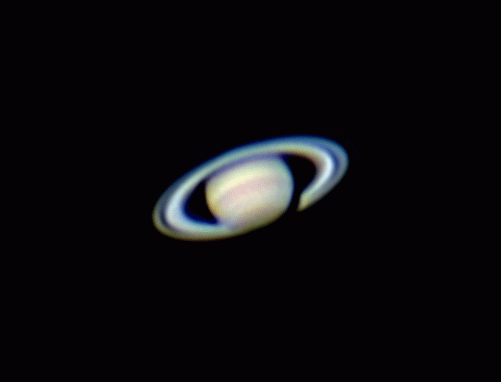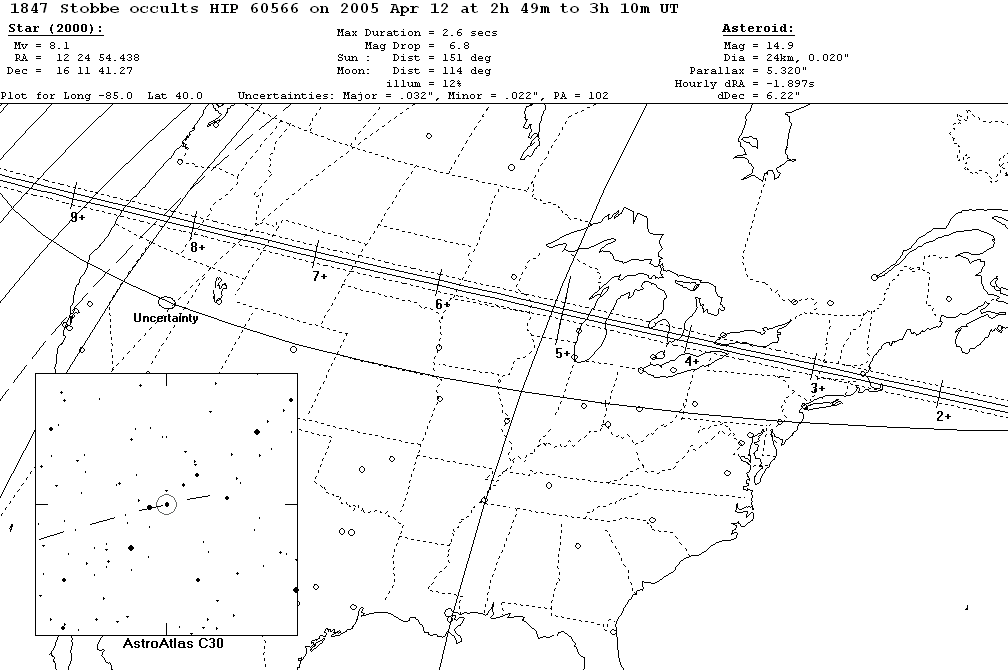
Map courtesy of Steve Preston -- see the Asteroid Occultation Update page for upcoming events.
See Guy Nason's summary of what we learned from the occultation.
On the night of April 11/12, 2005, the asteroid (1847) Stobbe was predicted to occult the star HIP 60566 for observers in the northeast US and central Canada.

Map courtesy of Steve Preston -- see
the Asteroid Occultation Update page
for upcoming events.
The RIT Observatory near Rochester, New York,
fell just outside the predicted shadow track, which lay between the black and blue straight lines on the chart below.
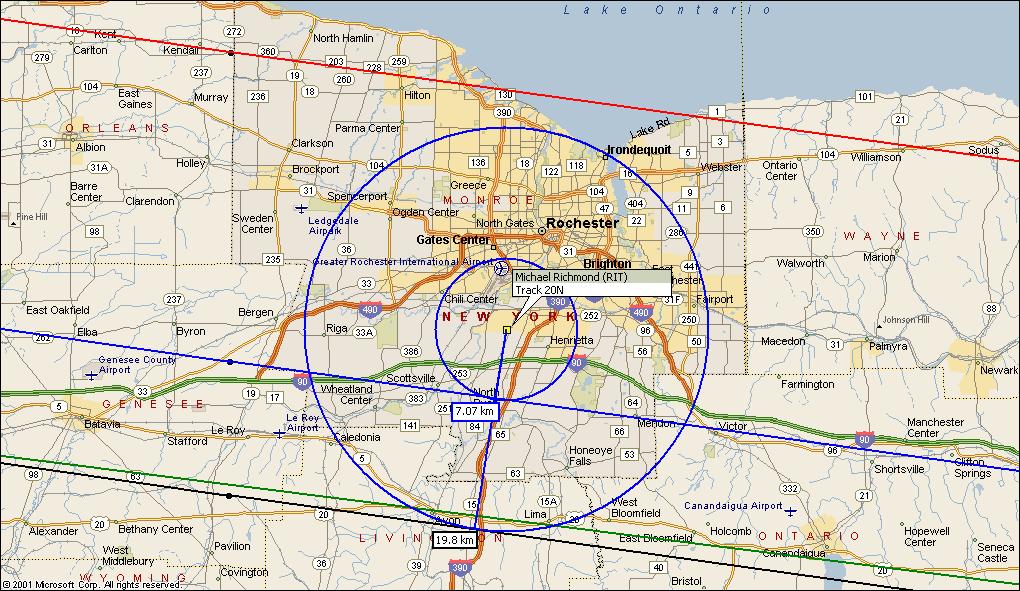
Thanks to Guy Nason for this map!
We set up to observe the event. Fellow physics professor Tracy Davis and physics major George Privon came to help out -- thanks!
Our setup was:
I arrived two hours before the event, and (foolishly) thought I had time to grab some pictures of Saturn while waiting.
Mistake number 1: try to do something else before the event.
I didn't turn to the target star until 40 minutes before the event.
We placed a PC-164C video camera on the back of the 12-inch telescope and ran the signal through a Kiwi OSD video time insertion unit: it places GPS-derived timestamps on every frame of the video. A test run a few nights ago showed that it worked fine, but tonight, the video signal kept flickering. We replaced a video cable, but still more flickering. Eventually, we discovered that the connector on the Kiwi unit was a bit loose.
Mistake number 2: wait too long to check the equipment.
Fortunately, Tracy found that if he held the cable onto the Kiwi box by hand, it would remain stable.
We had a VCR set up to record the video signal. We'd used this VCR for similar events before, but it wouldn't send the video signal through to our monitor tonight. We spent over 10 minutes trying to figure out what was going wrong. After the event was over, we realized that in the past, we'd used the remote control for the VCR to configure it for recording an input signal; we had been trying to push buttons on the front panel of the VCR instead.
Mistake number 3: forget how to use your equipment properly.
Anyway, we did manage to find the target star with a few minutes to spare. It was about eighth magnitude, and so barely visible in the finderscope.
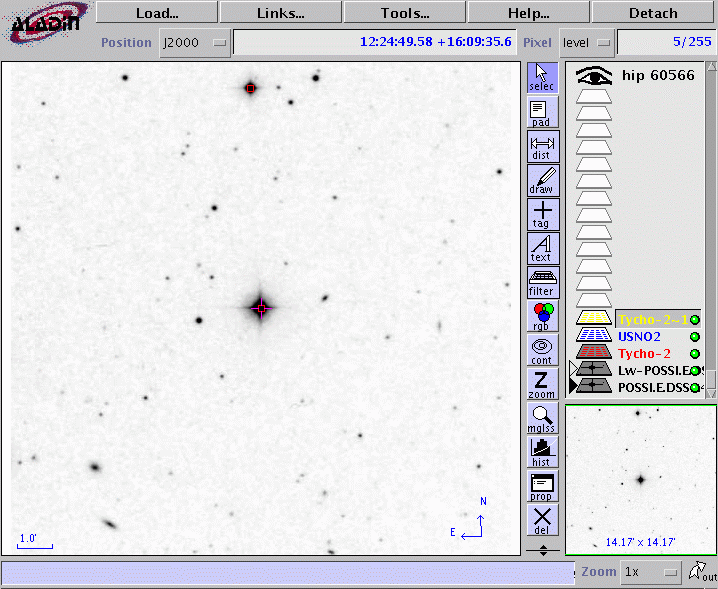
Now, in the tiny field of view of the PC-164C -- only a few arcminutes across -- we could see only a single star. In order to verify that this was HIP 60566, we slewed the telescope north (up on the television screen) to a bright star visible at the top of the chart above; we also slewed east (left on the television screen -- it matches the orientation of these charts when the video camera is mounted so the lettering on its side is right-side up) to the bright star visible in this larger chart.
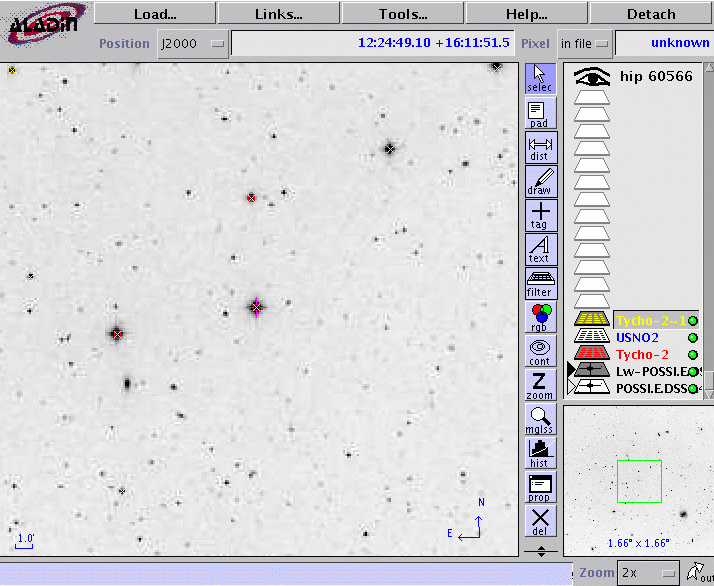
Since we saw these two bright stars at about the right distance from the target, and in the right directions, we concluded that we were on the target. And we were.
We simply looked at the monitor, where we could see the star and the Kiwi unit's on-screen display of time flashing by. All three of us watched and waited. At 03:03:20, the star completely disappeared -- very dramatic, as it had been saturating the monitor at magnitude 8. Between one and two seconds later, it re-appeared. All three of us judged that the dip was signficantly less than the predicted maximum of 2.6 seconds. You can see our best estimates in the report below.
We continued watching until 03:05:00 to see if any secondary events occurred, but we didn't see any.
Next time, I will resist the siren song of other projects while waiting for an occultation, set everything up a full hour in advance, and just sit there with a good book :-)
IOTA ASTEROIDAL OCCULTATION REPORT FORM
Asteroid (or other object):_ 1847 Stobbe _____ Star:___HIP 60566___________
Date (U.T.):____ 2005 Apr 12 _________ Predicted Time (U.T.):__03:03:30____
Observer Name:___Michael Richmond _________ Telephone:__ (585) 475-2538 ___
Postal Address:___Physics Dept., 85 Lomb Memorial Drive, Rochester, NY 14623
E-mail Address:___ mwrsps@rit.edu ______________ Fax:___ (585) 475-5766____
TELESCOPE: Aperture:_ 30cm Focal length:_300 cm Type:__Meade LX200 ______
Eyepiece Power: videocam Observing site name: __RIT Observatory ________
Longitude:__077:39:51.3 __________ Latitude:___+43:04:30.5_____________
Height above sealevel:_176 m_ How determined?:___GPS___________________
Sky Transparency (Circle one, or delete two): Good
Star Image Stability ("seeing"; as above): Good
Other Conditions: (Wind, Clouds, Lights, etc.):____________________________
EVENT TIMINGS: (All times in Universal Time)
Time Source:__GPS display Recording method: videocam w/ GPS time inserted
Was the Asteroid Visible in your Scope? ______ Approx. Limiting Mag.:______
Universal Time Estimated Accuracy, Remarks
h m s Reaction
Time,
Started Observing: 03_:_01:_00.___ (sec.) ____________________
Star and Object Merged: ___:___:___.___ __object invisible__
Disappearance: 03_: 03:_20.___ __.___ __+/- 0.25 sec______
Estimated Closest Approach: ___:___:___.___ ____________________
(if no D/R)
Reappearance: 03_:_03:_21.5__ __.___ __+/- 0.50 sec______
Star and Object Separated: ___:___:___.___ __object invisible__
Stopped Observing: 03_:_05:_00.___ ____________________
Was your reaction time applied to the above timings? _no______
If you could tell, did the object pass NORTH, SOUTH, EAST, or WEST of the
star (cicle one, or delete three)? If possible,
estimate the distance of closest approach in arc seconds: _______
List all Interruptions in Observing: Reason
From ___:___:___ to ___:___:___ __________________________________
From ___:___:___ to ___:___:___ __________________________________
Additional comments: _viewed by eye videocam images on TV w/ GPS time overlay
Send Jan Manek Fax: sorry - no fax numbers
report to: Stefanik Observatory E-mail: jan.manek@worldonline.cz
Petrin 205 If an occultation is timed, copy to:
118 46 Praha 1 dunham@starpower.net
Czech Republic
Note added several days later:
Guy Nason, an occultation observer in Ontario, has collected reports on this event from a number of astronomers in the area. Here is a portion of his summary -- it places some pretty strong constraints on the maximum size of Stobbe.
As far as I know, there were 12 observers at 10 stations from Ithaca, NY to Woodstock, ON. All were single observer stations except for "Team R.I.T.", consisting of Michael Richmond, Tracy Davis and George Privon at the Rochester Institute of Technology's observatory. We were scattered from Track 115N to Track 39S. Only one station reported an occultation, but two had very near misses, north and south, that appear to put a fairly tight constraint on the path and the size of the asteroid. Here's the chart: (the "track" column describes the distance in km between the centerline of the asteroid's predicted shadow track and the observer)Track Name Result Method Dur. Nearest Town 115N Tom Luton No report yet --- Coburg, ON 100N Frank Dempsey Observed Miss Visual Pickering, ON 66N Jim Picha Observed Miss Visual Toronto, ON 65N Andy Beaton Observed Miss Visual Toronto, ON 48N Colin Haig Observed Miss Video Milton, ON 44N ---------- North 1-Sigma Line --------- 44N Roger Hill Observed Miss Video Milton, ON 33N Eric Briggs Observed Miss Video Mississauga, ON 20N Team R.I.T.* Observed Occ'n Visual 1.5 sec Rochester, NY 13N ---------- Northern Limit ---------- 0S ---------- Centreline ---------- 3S Guy Nason Observed Miss Video Woodstock, ON 13S ---------- Southern Limit ---------- 39S Bruce Thompson Observed Miss Unspecified Ithaca, NY 44S ---------- South 1-Sigma Line ----------* Michael Richmond, Tracy Davis and George PrivonThis is a preliminary overview only and is not intended to be a definitive reduction of the results. Rather, it's intention is to promote a sense of teamwork by showing participants how they contributed to the whole enterprise; to show non-participants how all of this can come together to reduce uncertainties in asteroidal affairs; and to encourage non-participants to get involved in future events. Although the asteroids may travel in a vacuum, there's no need for us to.
In this particular case, although most participants failed to see the target star disappear, the results are interesting, nonetheless. For one thing, at 55, the Rank was quite low and the path, only 26 km across, was narrow. The station distribution across the path was such that a miss by everyone was quite possible and would have settled nothing. There were holes more than large enough to permit undetected passage between Frank Dempsey and Jim Picha; and between Bruce Thompson and me. Of course, the path could have shifted beyond Tom Luton in the north or Bruce in the south. If any one of these four scenarios had occurred, we would have had no idea where the asteroid went. More observers to plug the holes would have been helpful. As it happened, we are fortunate that Team R.I.T., despite wrestling with Murphy's Law most of the evening, still managed to observe and time a hit. Because they were in place, we know that the asteroid passed through a 36-km-wide hole between Eric Briggs and me; and therefore, that asteroid (1847) Stobbe must be < 36 km wide, in one dimension, anyway. Uncertainty reduced.
As mentioned in the narrative above, I spent a half hour or so before the occultation taking video of Saturn with the ToUCam on the 12-inch telescope. I placed the camera at Cass focus, set the camera's "gamma" control to zero, and tried several different exposure times.
On thing that puzzled me was that an exposure time setting of 1/33 produced a picture which looked pretty nice on the screen in real-time; just a bit dim, but pretty good (see picture on left below). Yet when I tried changing the exposure time to 1/25 of a second, the image seemed overexposed (see picture on right below)
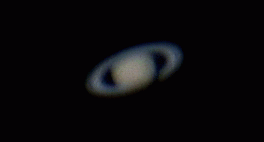
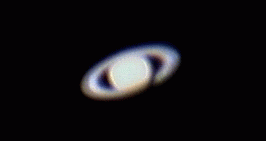
Single frames with exposure settings of 1/33 (left) and
1/25 (right)
The Yahoo "ToUCam" group mentioned some careful measurements of the true exposure time for the ToUCam, which turn out not to be very close to the values indicated by the control software. I found m.m.j.meijer's experiments timing the shutter clever and informative. He finds that when running at 5 frames per second, the ToUCam exposure setting of 1/25 actually yields 1/5 of a second (200 ms), and the setting of 1/33 actually yields 1/10 of a second (100 ms). Aha! That big jump of a factor of two in exposure time matches the appearance of my pictures.
I combined three video clips with a total of 1200 frames of Saturn with Registax to make a single composite. I picked the best 1000 frames and combined them in the ordinary way (I tried resampling the images in the "Optimize" stage, using "Bell" and "1.5", but the resulting image was mess). I did a bit of wavelet enhancement in Registax, then exported the image to Photoshop to do a bit more: gentle unsharp masking, boosting the brightness levels, and resizing the image. Here are some of the images which came out of all the fiddling:
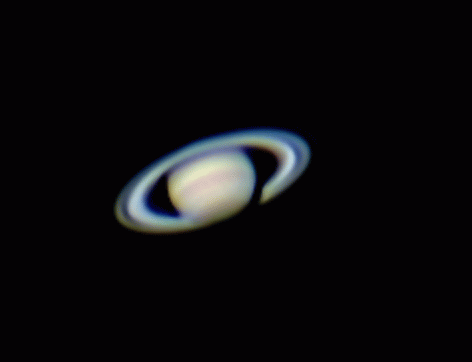
This pair shows a before-and-after version: before doing extra sharpening in Photoshop (on left), and afterwards (on right). I think I prefer the "before" version ...
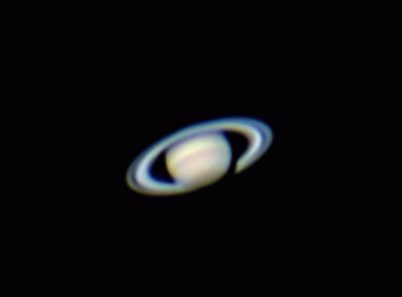
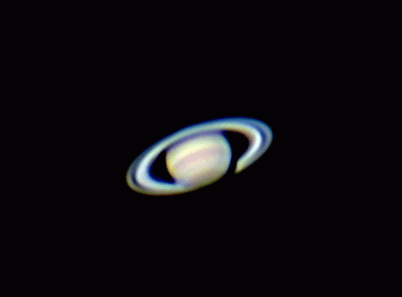
Finally, my favorite combination of resizing and sharpening:
